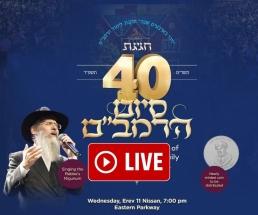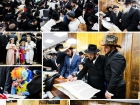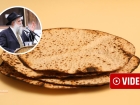Yes, There is Chabad in Kostrama
From Beis Moshiach Magazine: Meet Rabbi Nissan Ruppo, the Rebbe’s shliach to Kostroma, Russia since 5753 (2003), rabbi of a community well aware of its Chassidic history that is proud of the fact that the Rebbe stayed in their town for ten days • A Yud-Beis Tammuz interview • Full Editorial
Menachem Ziegelbaum, Beis Moshiach
The Chag Ha’Geula, Yud-Beis Tammuz 5767, will go down in the Jewish history of Kostroma as the day that marks the renewal of the community that was nearly eradicated. Many years ago, there were laws that prevented Jews from living there. This was followed by communist decrees which led to an assimilation rate as high as 95%.
A short while after the shluchim, Rabbi Nissan Ruppo and his family arrived in town, the shul in which the Rebbe Rayatz davened in during his exile which was under lock and key for many years, underwent major renovations and was officially reopened. Once again, the Jews of Kostroma could be proud.
That festive event marking the opening of the shul was precisely 80 years since the Chag Ha’Geula and 100 years since the founding of the shul in Kostroma. Since the galus and Geula of the Rebbe Rayatz in this city, Kostroma probably did not see a gathering of Jews such as this with public figures coming to honor the Jewish community. The heartwarming sight of the district leader alongside the rabbi of Russia, the mayor, local government representatives together with shluchim of the Rebbe, stood out on this very special Yud-Beis Tamuz 5767 in Kostroma. “Jews can now operate with their heads held high, without fear,” the mayor said.
The Non-Jews will bake the Matza…
Kostroma is the city closest to Moscow. R’ Ruppo himself was born in Moscow 40-odd years ago.
“Boruch Hashem, both my parents are Jewish, but their world view was no different than many other Jews who intermarried. The only Jewish thing I knew was that we are Jews and we bought matza once a year for my grandmother who ate it together with bread.
“I attended the schools of goyim, ate their food, celebrated their holidays and generally did not feel any different than them. I remember that when I was older, I went with my mother to the big shul in Moscow to buy matza for my grandmother. This was during the period when communism was already waning and the line for matza was longer than usual.
“At a certain point, the person in charge announced that they had run out of matza, but not to worry, because there would be a new supply on Sunday. He promised that they would be baking more matza on Saturday. To the few who said it was forbidden to work on Shabbos, a fact which many knew, as did I, he said: Jews won’t be baking the matza, gentiles will. Ignorance was widespread.
“When I was bar mitzva, I celebrated a little and that was only because of the prevalent spiritual arousal at the time. I raised a cup of champagne and my father explained that in Judaism at this age you become an adult.
“When I was fourteen my mother took me to a shul for the first time. Most of the Jews who went to shul remained outside. Inside there were a few Jews who read in a language that was unfamiliar to me. The service was more of a Jewish social event and display of Jewish identity than actual prayer. People simply did not know anything. A few remembered something from their grandparents. I remember how one day, my mother brought home a booklet about the mitzva of mezuza and it mentioned the Lubavitcher Rebbe. I asked who he was but she did not know.
“In the summer of 5753, I was registered for day camp with the Jewish Agency. They did their best to convince Jews to make aliya. There was no Judaism in camp; it was more about identifying with Israel. When camp was over my mother registered me for Camp Gan Israel. She had gone to the principal of the Jewish school, and he had suggested that before school began it would be a good idea to send me to camp.
“I received my first, massive dose of Judaism in camp. On the first day, I wore tzitzis and on the second day, I put on tefillin. On the third day, I agreed to undergo a bris. The interest was so enormous that out of seventy children who attended camp, 56 of them had a bris on the same day. Only three declined and the rest were already circumcised.
“I finished camp having resolved to keep kosher. I did not know much about kashrus, but I was given pamphlets and when I went home, my mother thought it was a passing fad like many of my childhood meshugasin. She soon realized that I was serious about it.
“I attended the school of R’ Kurevsky for a few months where I learned Hebrew, among other things, but this wasn’t enough for me. I then attended Yeshivas Tomchei Tmimim in Marina Roscha.”
The Ruppo family made aliya in the winter of 5753 and settled in Petach Tikva.
I ended up in Ohr Simcha in Kfar Chabad. Many young Russian kids learned there and the atmosphere was special. I learned there for a year and a half and from there I went to the yeshiva in Tzfas which shaped my life and my shlichus. During the two years that I learned there I was given the foundation for my Chassidic life. My feeling of hiskashrus to the Rebbe I owe to the rabbanim and mashpiim in that yeshiva.”
LETTER FROM THE REBBE
In 5757, as a talmid of the yeshiva in Tzfas, Nissan went on Merkos Shlichus to cities in Russia. He began his trip in Nizhny Novgorod and also visited Kostroma, which is considered a small city with only a quarter of a million people and not a large Jewish community.
“I was surprised to see an active shul while in other cities of the CIS that had bigger communities, there were still no shuls. Although it was a small city, some Jews decided to open a shul that would serve as a Jewish center. R’ Moshe Tamarin of Moscow would come occasionally to support the Jews of the community.
“After some days of shlichus there, I continued on my way. I did not imagine that I would come back to live there.
“In 5759, I went on Kevutza to 770, after which I did not know what to do next. I very much wanted to continue spreading Chassidus in Russia, but I had some good offers for outreach positions in the US. On the one hand, all the terms that I was promised in America were tantalizing; on the other hand, I knew that in Russia I would be able to do my best work. I wrote to the Rebbe and opened to an answer in volume 18 of Igros Kodesh, page 90. I couldn’t have asked for a clearer answer. The Rebbe negated the suggestion to work in New York and sent me to places that really needed me.
“When I finished learning for smicha in 770, I went to work in the mesivta in Moscow.
“When I finished my military service in Israel, I returned to Moscow. I asked R’ Lazar, who knew me well, to give me a city where I could work on a permanent basis. I was given Kostroma, a small city, but a location with a lot of potential work. I didn’t have to do much research, because I already knew the place from my previous visit. I left that same day.
“The community had asked for a permanent shliach in the past, but due to the size of the city, they had preferred sending shluchim to larger cities. R’ Lazar then decided that the time had come for this city, which is significant in Chabad history, to have a shliach.
“We arrived there on 27 Adar 5760. The first thing we did was make a Jewish summer camp for families. I remember that the first Jewish family we visited was a family I had met in Liadi at the beginning of my Merkos Shlichus trip. They told me back then that they lived in Kostroma.
“Their ignorance of things Jewish was so vast. She told me that 16 years earlier, the community decided to pull themselves together; they had asked the Jews of the city to come to the shul on Shavuos. On the table in the lobby of the shul was a paper and pen so everyone could sign in.
“Two years later, on Pesach, the community rented a hotel nearby that was run by a local Jew. The community organized buses on Yom Tov…
“This woman is a Doctor of Biology and works in the dairy industry. After we had settled in the city, she asked me how one koshers milk.
“I asked her why she was asking, and she said it was because she noticed we did not drink milk and she wanted to bring us milk from her place of work. I told her that she had to be Shomer Shabbos in order for us to drink the milk. She asked me what I meant and I briefly explained and added, ‘If you keep Shabbos, we can drink the milk that you milk yourself.’ She took me seriously and began keeping Shabbos. At a later point, she and her sister, a university professor, committed to keeping kosher.
“Because of her work, she moved to another city and left us her apartment so we could open a preschool. She made aliya a few years ago and settled with her family in Yerushalayim. I recently visited them and they are a beautiful religious family. She has six grandchildren and her son learns in kollel all day. I ate in her home and thought about how far they had come and what a difference the Rebbe made in their lives.”
CHANGES IN KOSTROMA
R’ Ruppo has a daunting task in uniting the community and fighting assimilation.
“The problem of assimilation is enormous, and it exists throughout the former Soviet Union. People here know that if they are not Jews according to Halacha, even if they regularly attend shul, they will not get an aliya to the Torah or any other kibbudim. We work hard with Jewish youth so that at least, in the next generation, there will be fewer instances of intermarriage, but the situation is bad.”
R’ Ruppo and his wife run a shul which is a Jewish center, as well as directing a preschool and a Sunday school. The shliach also runs camps and seasonal programs throughout the year along with weekly shiurim for boys and girls.
Every year, R’ Ruppo sends groups of boys to Moscow for brissin. Many people have committed to kashrus and tefillin. This is how a Jewish community that was nearly wiped out comes to be flourishing anew.
“When I look back over the twelve years we have been working here, I can’t help but get emotional. Quite a few families changed their way of life and have become religious. The only sticking point is that they leave for Eretz Yisrael.”
Breathing Redemption on the Streets
When on shlichus in a city like Kostroma, history plays a part in day to day activities.
“There are still descendants of R’ Kugel in Kostroma. He is the one who hosted the Rebbe Rayatz during his exile. The Rebbe, in one of his sichos, referred to the joy of R’ Kugel’s son when he heard of the release of the Rebbe and how he climbed a fence and stood on his hands. R’ Kugel had a daughter, Roza (see box), who was 12 at the time. She made aliya and lived in Beer Sheva until her passing six years ago. She has six grandchildren. Four made aliya with her and the other two live in Kostroma. The great-grandchildren learned in our preschool and take part in all our programs.
“It is moving to see how the Rebbe paid them back. R’ Kugel hosted the Rebbe for a few days, but shortly after the Rebbe was released, he was arrested and accused of underground Jewish activity. He died in exile in 5705/1945. Today, despite the upheavals that many of his descendants experienced, many of them are connected to Lubavitch.”
RECLAIMING THE PAST
Kostroma was one of the cities outside the Pale of Settlement. Jews without a permit were not allowed to live there. Only those Jews with needed professions were able to obtain a permit. Of course, a rabbi was not one of those professions recognized by the government.
“One day, R’ Tzvi Hirsch Friedman came to town. He was a distinguished Torah figure. In order to obtain permission to remain in the city, he announced that he was setting up a weaving factory. His brother sent him a weaving machine and he employed two gentile women who worked for him while he devoted himself to running the Jewish community.
“The new law of the present era, after communism, states that all religious buildings must be returned to members of that religion. Many religious buildings, which had been confiscated under communism, were returned to Jews. We submitted a request to receive the house of the rav too, but it wasn’t simple since he was listed as the owner of a weaving factory. We spoke with the mayor and she managed to arrange the building for us for one year, which was then extended to five years. We still didn’t renovate the building, because we were afraid that it would be taken back from us.
“Thanks to R’ Lazar’s intervention, we were able to get the building for forty years. Then we did a massive renovation. In 5767, eighty years since the release of the Rebbe Rayatz, we dedicated the building and put the preschool in there. The mayor, who is not Jewish, was invited too. In her speech, she said she knew about all the problems the Jews had back in the day, which made it necessary for the rav to hide his true job, ‘and today we have R’ Nissan who works openly and we are happy about this. We will do all we can to help him.’”
What is it like to work in the city which received the news of the Rebbe Rayatz’s release?
It feels special. I feel it not only on the day of his Geula each year, but every single day. Although the shul underwent renovations, we left the original paint that was there when the Rebbe davened there. I live a minute’s walk away from the house where the Rebbe stayed. In the center of the city there is still a KGB building where the Rebbe received his release papers. So I am always surrounded by memories.
People meet and see the descendants of R’ Kugel, with whom the Rebbe stayed. We are constantly living with it. Not just me, but all the members of the community. On the wall in the entrance hang documents from the archives that we were able to get hold of concerning the Rebbe’s stay in the city and his release document. At every meeting of district officials, I am invited to speak on behalf of the Jewish community. What could be a greater transformation than that?
***
The granddaughter of R’ Kugel told us that the previous mikva was in the shul. When we renovated the kitchen, we found the mikva. It seems it’s the mikva that R’ Michoel Dworkin fixed in anticipation of the Rebbe Rayatz’s arrival and it is the mikva that the Rebbe used when he was here.
How do you spread the message of Moshiach in this spiritual desert? Do you talk about it?
We are constantly talking about Moshiach! Boruch Hashem, talking about Moshiach doesn’t bother anyone in Kostroma. It’s like any other mitzva. And anyway, what is Moshiach? When a Jewish woman whose father and grandfather, four generations of gentiles, convinces her husband to be circumcised, that is Geula. When a woman wants to have a wedding under the open sky because she heard it is a minhag, that is Geula. When not just old people but young people – people who knew nothing about Judaism – also come to shul, that too is Moshiach.
THE HOUSE THE REBBE LIVED IN
The house in the picture, according to R’ Ruppo’s research, is where the Rebbe Rayatz lived when he was exiled to Kostroma. The Rebbe lived in Kostroma from 5 Tammuz until 14 Tammuz. R’ Eliyahu Chaim Altheus, R’ Michoel Dworkin, and Rebbetzin Chaya Mushka were with him.
The house was located on 3 Nikitaskaya Street in Kostroma and was razed forty years ago. The granddaughter of the shochet, R’ Yerachmiel Kugel, in whose house the Rebbe stayed, brought the picture to R’ Ruppo. She discovered the picture after many years had passed.
The shochet’s daughter, Mrs. Rosa Melamed, recounts what she remembered:
“I remember that when the Rebbe arrived in Kostroma, there was excitement and commotion in the city. Even the goyim came out to see the ‘Man of G-d.’ I remember how people stood on the rooftops and outside the fences. We hosted the Rebbe and his escorts. It was a big house and the Rebbe was given a room.
“I even remember that there were people who wanted to see the Rebbe, and one of them, who wanted this very much, was even received. After his release, the Rebbe was given an entire compartment on the train that brought him back from Kostroma. In the interrogations of my father which were conducted later, his hosting the Rebbe and his escorts came up. This even appears in the KGB file on my father. He was given ten years in Siberia.
“My father was a Chabad Chassid, shochet, and mohel. He was needed in the city and surrounding towns and was asked to do brissin even in Leningrad and Moscow. After the shul was closed, a minyan was held in our house even though the government had confiscated the Sifrei Torah.”
*
The magazine can be obtained in stores around Crown Heights. To purchase a subscription, please go to: bmoshiach.org
Originally published in Beis Moshiach #1219
185
Join ChabadInfo's News Roundup and alerts for the HOTTEST Chabad news and updates!











































